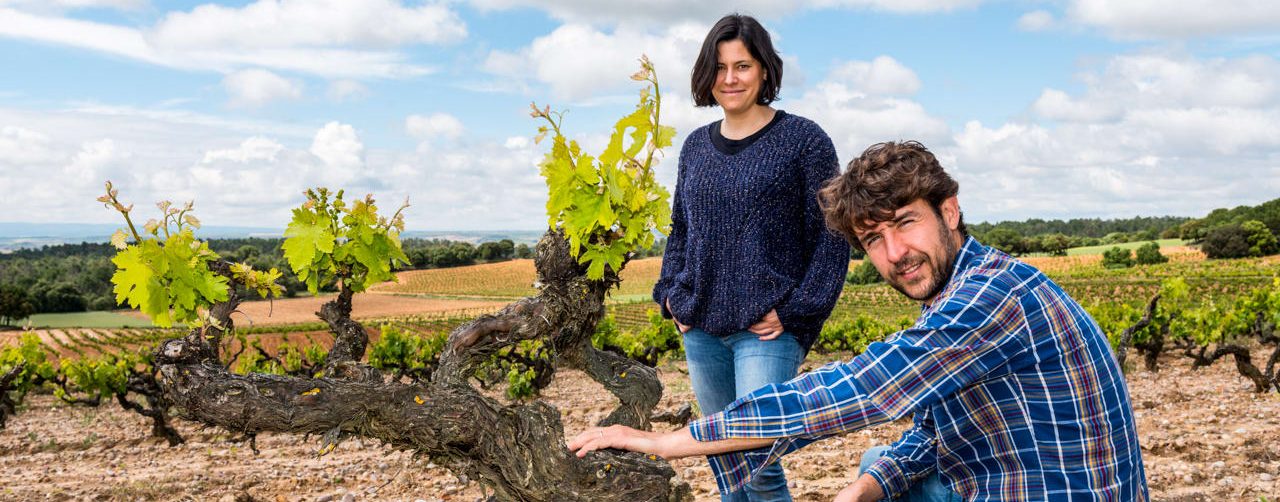



Jorge Monzón and Isabel Rodero, the husband and wife team behind Dominio del Águila, shows us both the forgotten history and bright future of Ribera del Duero and its wines. With more than century old vines, old local varieties, a wide genetic diversity, countless of clones and cautious wine making they are reshaping and redefining the way the wines of Ribera del Duero are seen upon.
For Jorge it sort of started in France. He left his hometown of La Aguilera to study viticulture, oenology and soil at the universities in Bordeaux and Beaune. During his time in Burgundy he somehow made his way into Domaine de la Romanée-Conti where he worked under cellar master Bernard Noblet observing and learning every aspect of their methods. After DRC Jorge returned home, here he worked a few years at Vega Sicilia before taking on the position of technical director at Arzuaga-Navarro. During this time at these different estates and with his accumulated knowledge Jorge began to purchase vineyards in La Aguilera. His time at DRC had given Jorge an understanding of the importance of terroir and tradition, at Vega-Sicilia he’d also understood how essential old vines and old clones were if you want to make really good wine in Ribera del Duero. For this reasons the vineyards Jorge sought were old vineyards, really old. These were often plots in danger of being ripped up due to their content of low-yielding old local varieties and to make place for trendy Bordeaux varieties or high-yielding clones of Tempranillo.
Some of Jorge and Isabel’s vineyards were planted before phylloxera, or right after it struck the vines around his home village. These were planted exactly as they had been for centuries – predominantly Tempranillo with a wide genetic diversity along side Albillo, Tempranillo Gris, Cariñena, Garnacha, Bobal, Bruñal and other varieties so obscure that they haven’t been identified yet. Ranging in age from 60-150+ years old, it is surprising that these vines survived at all considering the recent trend in Ribera del Duero for everything new, shinny and perfectly predictable.
Dominio del Águila was founded 2010 and since 2013 Jorge dedicates all his time here. Today the estate tends 35 hectares of vines. 30 of these are older than 50 years and 5 “young” hectares, i.e. below 50 years of age, so not so young really… Jorge and Isabel are true growers, working organically. They really try hard to do everything in an artisanal way, being very respectful with nature and creating a symbiosis between tradition and technical knowledge. From the use of herb-infused juices to treat the vines to the cautious vinification. They do not vinify every bunch of grapes that they grow and still sell much of their fruit to wineries around in the region, including Vega-Sicilia and Arzuaga — tells of the quality of fruit!
When it comes to the winemaking, also this aspect at the estate is historic and traditional. The winery consist of an ancient bodega dating back to the 1600’s which Isabel, being an architect, restored. So also with the six deep subterranean cellars dating back to 1400’s. Harvest is manual, the must is never altered, fermentations occur spontaneous without any additions with the exception of some low sulphuring. They are co-fermented, blue and green varieties mixed, and maceration is done gently through foot-pigeage. After primary fermentation the wines are transferred to oak barrels in the cellars. Their cold, subterranean cellars ensure that the evolution of their wines proceeds slowly, allowing for the development of greater complexity and nuance. Wines are neither filtered nor fined.
At Dominio del Águila the historic wine style Clarete is also being revived. It’s pink, it’s not a rosé, it’s a Clarete. Red and white varieties harvested and fermented together, with long ageing in oak. A fantastic white wine of Albillo is also made. It has gotten great international acclaim and in extension caused the Consejo Regulador to permit white wines under DO Ribera del Duero, previously is has been classified under ‘Castilla y Léon’.
It is safe to safe that Jorge and Isabel with their Domino del Águila are in the forefront of not only Ribera del Duero but also the whole of Spain, the world of wine if you will! These wines are masterpieces of the highest pedigree full of concentration, complexity, freshness and history. Don’t miss this fantastic story — and it has merely just begun.
Pícaro Clarete and Tinto are field blends, strictly selected from parcels chosen for their quality, but also in response to vintage conditions. In warmer years, cooler sites are favored and in cooler vintages, warmer sites are utilized. The soils for these two wines are heavier in clay, which in a dry climate like Ribera del Duero, prevents vine stress and promotes a even and simultaneous ripening of both fruit and stems – vitally important for whole cluster, natural fermentations.
Their Reserva comes from a group of parcels that share common characteristics: vines planted before 1930, on predominantly north-facing sites with sandy clay limestone soils, and utilizing all the varieties present in the vineyard to add complexity to the Tempranillo. This cuvée represents the character and terruño of the old vines of La Aguilera.
Peñas Aladas is a zone within the village of La Aguilera where Jorge and Isabel own a cluster of vineyards. The soils here are thin, sandy clay over hard limestone bedrock. The structure to the fruit grown in Peñas Aladas requires a long period in oak to soften, evolve, and open up. The goal at Dominio del Águila was not to make a Gran Reserva because it was expected, but because the terroir demanded it.
Canta la Perdiz is a single vineyard wine made from vines between 100 and 150 years with the oldest vines being ungrafted. South-facing but at high elevation, the soils here are shallow, gravelly clay over a friable and horizontally fractured limestone bedrock. With a softer structure than Pena Aladas, it requires less time in barrel, and shows a wildly aromatic and floral aspect that sets it apart from the other sites that Jorge and Isabel farm.
Various versions of Albillo are planted in the vineyards of Dominio del Águila and Jorge and Isabel even own two rare, small parcels that are planted entirely with Albillo. Jorge feels that his best vines of Albillo – small clusters of deeply golden berries – demanded to be segregated and made into a tiny production white wine. This marvellous creations lead to the DO permitting white wines be labelled under Ribera del Duero.